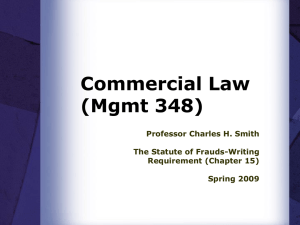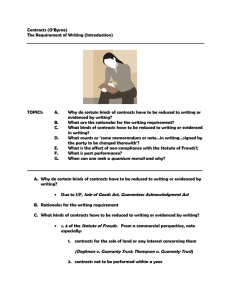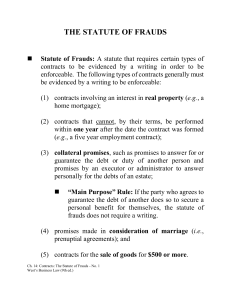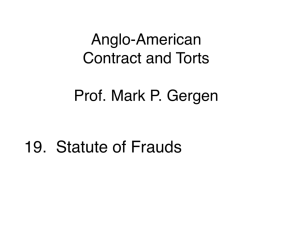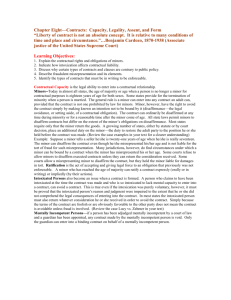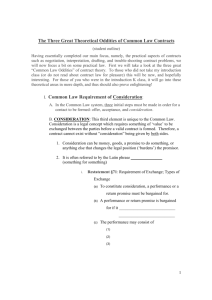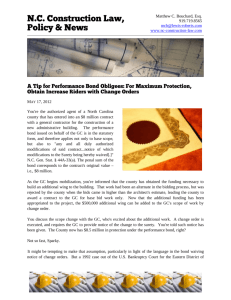FRAUD – RIGHTS OF ACTION AND DEFENSES
advertisement
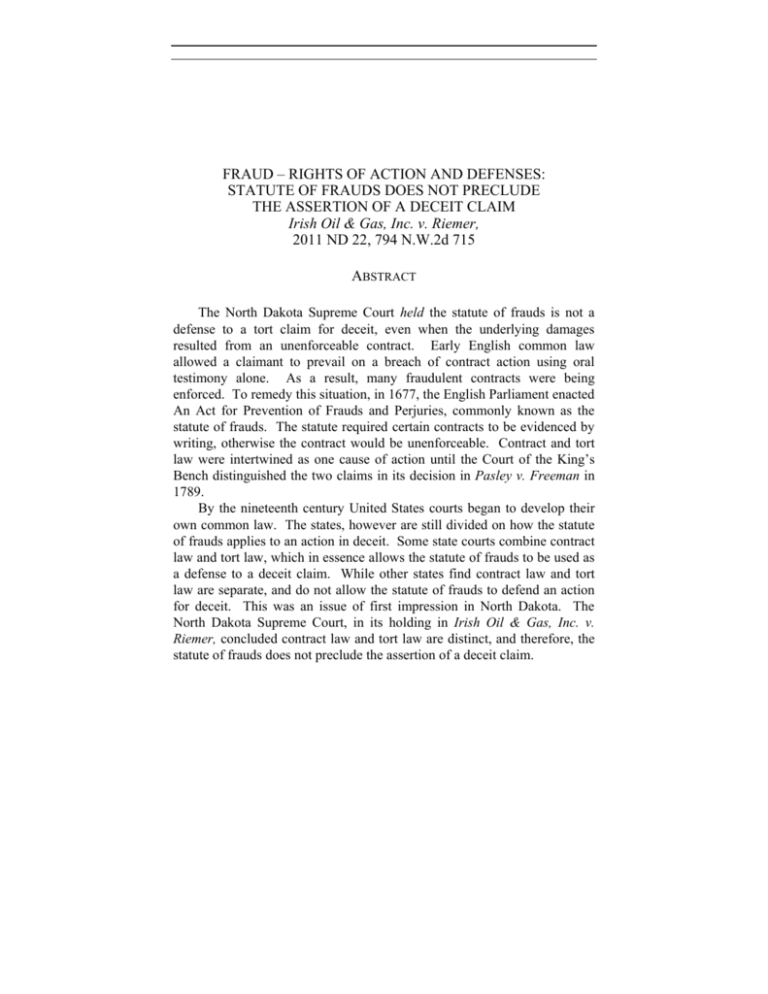
FRAUD – RIGHTS OF ACTION AND DEFENSES: STATUTE OF FRAUDS DOES NOT PRECLUDE THE ASSERTION OF A DECEIT CLAIM Irish Oil & Gas, Inc. v. Riemer, 2011 ND 22, 794 N.W.2d 715 ABSTRACT The North Dakota Supreme Court held the statute of frauds is not a defense to a tort claim for deceit, even when the underlying damages resulted from an unenforceable contract. Early English common law allowed a claimant to prevail on a breach of contract action using oral testimony alone. As a result, many fraudulent contracts were being enforced. To remedy this situation, in 1677, the English Parliament enacted An Act for Prevention of Frauds and Perjuries, commonly known as the statute of frauds. The statute required certain contracts to be evidenced by writing, otherwise the contract would be unenforceable. Contract and tort law were intertwined as one cause of action until the Court of the King’s Bench distinguished the two claims in its decision in Pasley v. Freeman in 1789. By the nineteenth century United States courts began to develop their own common law. The states, however are still divided on how the statute of frauds applies to an action in deceit. Some state courts combine contract law and tort law, which in essence allows the statute of frauds to be used as a defense to a deceit claim. While other states find contract law and tort law are separate, and do not allow the statute of frauds to defend an action for deceit. This was an issue of first impression in North Dakota. The North Dakota Supreme Court, in its holding in Irish Oil & Gas, Inc. v. Riemer, concluded contract law and tort law are distinct, and therefore, the statute of frauds does not preclude the assertion of a deceit claim. 744 NORTH DAKOTA LAW REVIEW [VOL. 87:743 I. FACTS ........................................................................................ 744 II. LEGAL BACKGROUND .......................................................... 746 A. EARLY ENGLISH LAW FOR CONTRACTS AND TORTS ........... 746 1. Assumpsit: The Remedy for Breach of Contract ........... 746 2. Derry v. Peek: Proof of Fraud ...................................... 747 B. THE PROBLEM AND SOLUTION TO ORAL PROMISES: AN ACT FOR PREVENTION OF FRAUDS AND PERJURIES............. 749 1. The United States Adopts the Statute of Frauds ............. 749 2. Applying the Statute of Frauds to a Tort Claim ............. 750 III. ANALYSIS ................................................................................. 752 A. NORTH DAKOTA SUPREME COURT HOLDS THE STATUTE OF FRAUDS DOES NOT BAR A TORT ACTION FOR DECEIT .. 752 1. Fraud or Deceit .............................................................. 752 2. The Cause of Action ....................................................... 753 3. The Jurisdictional Divide: Using the Statute of Frauds as a Defense to a Tort Claim in Deceit .......................... 753 a. Essential Element of the Claim ............................... 754 b. Indirect Enforcement of an Oral Contract ............... 755 c. Admissibility of Oral Testimony ............................. 756 d. Perpetration of Fraud ............................................... 756 IV. IMPACT...................................................................................... 757 V. CONCLUSION ........................................................................... 758 I. FACTS In January and February 2008, Irish Oil & Gas, Inc. (“Irish Oil”) entered into oil and gas leases with the “Riemers”1 for a single parcel of land they owned jointly.2 A Letter Agreement in Lieu of a Draft for Oil and Gas Lease Bonus Consideration accompanied each lease, offering a bonus 1. The parties to the lawsuit, collectively known as the “Riemers” are: Gerald C. Riemer, Doris E. Riemer, Lillie J. Riemer, and Joanne Johnson. Irish Oil & Gas, Inc. v. Riemer, 2011 ND 22, 794 N.W.2d 715. 2. Id. ¶ 2, 794 N.W.2d at 716. 2011] CASE COMMENT 745 consideration payment to be made within sixty days and a one-sixth royalty payment.3 On March 24, 2008, Gerald C. Riemer (“Riemer”) called Irish Oil and spoke with the company’s landman, Clarence Hertz.4 Riemer asked why the first bonus payment had not yet arrived.5 T.P. Furlong, the vice president for Irish Oil, called Riemer on March 25, 2008, stating there were title issues and requested an extension of time to pay the bonus consideration.6 Riemer gave Irish Oil the impression he was the advocate for the family, and he allegedly gave approval for the extension.7 T. P. Furlong mailed a letter memorializing the conversation he had with Riemer on March 25, 2008.8 Riemer did not respond to the letter.9 On April 30, 2008, the Riemers signed an oil and gas lease with Continental Oil Company for the mineral rights which had been leased to Irish Oil.10 On May 26, 2008, Irish Oil sent Riemer a check for $10,640.00.11 Riemer sent the check back to Irish Oil with a note stating, “sorry I leased it to another company.”12 On October 6, 2008, Irish Oil sued the Riemers for breach of the leases, and on September 1, 2009, requested leave to amend the complaint to add a claim against Riemer for deceit.13 All parties filed motions for Summary Judgment.14 The district court denied Irish Oil’s motion to amend its 3. Id. ¶ 2. The letter stated, Irish Oil & Gas, Inc. is interested in acquiring an oil and gas lease on the above referenced mineral interest, which you appear to own mineral interest, and is offering a bonus consideration payment of $160.00 per acre, for a primary term of five years, and a 1/6th royalty in the event of production . . . . Within 60 days upon receipt of the signed lease, and subject to approval of title, with right of payment extension of 30 additional days, in the event of title curative issues, from expiration of original 60 days, you will receive a check in the amount of $10,640.00. On January 15, 2009 you will receive the balance of bonus consideration in the amount of $10,640.00. Id. 4. Id. ¶ 3. 5. Id. 6. Id. 7. Id. ¶ 4, 794 N.W.2d at 717. 8. Id. ¶ 3. The letter stated: Please accept our apologies for the delay. . . . We through examination of title have encountered title issues . . . we will have to further examine documents. . . . This may take as long as the first of June, but if it takes longer than June 15th we will contact you to either extend the time to pay or release our leases of record. [I]f this does not correctly memorialize our conversation please feel free to contact me. . . . Id. 9. Brief for Respondent at 5, Irish Oil & Gas, Inc. v. Riemer, 2011 ND 22, 794 N.W.2d 715, (No. 20100064). 10. Irish Oil & Gas, Inc., ¶ 4, 794 N.W.2d at 717. 11. Id. 12. Id. Lillie J. Riemer also voided a check she received from Irish Oil after May 17, 2008. Id. 13. Id. ¶ 5. 14. Id. 746 NORTH DAKOTA LAW REVIEW [VOL. 87:743 complaint, concluding no valid modification of the leases were made and any dispute over the facts related to the modification was irrelevant.15 The district court held the provision in the lease requiring judicial determination of a breach was not applicable to the circumstances.16 The district court granted Riemers’ motions for Summary Judgment, dismissing Irish Oil’s complaint with prejudice.17 II. LEGAL BACKGROUND A. EARLY ENGLISH LAW FOR CONTRACTS AND TORTS Deceit occurs when a party willfully or recklessly misleads another party to act on a false claim.18 The early English courts were highly controversial with regard to deceit claims for contractual breaches.19 In one of the earliest recorded cases, the Court of Common Pleas held a contractual matter may be converted, after the fact, into a claim for deceit.20 Later, in 1415, the same court held “if this action [breach of promise] is maintained, one shall have trespass for breach of any covenant in the world.”21 In 1423, the Justices were unanimous holding there could be no cause of action for the breach of an oral promise.22 1. Assumpsit: The Remedy for Breach of Contract In early medieval common law, claims seeking the repayment of a debt or other matters could only be pursued through a writ of debt.23 Covenant was not applicable to oral promises, and the promise was not the heart of the theory for the action in debt.24 An action in debt was available to plaintiffs “who orally promised to pay,” and in cases “in which no promise had been made at all.”25 The “attendant circumstances . . . were the basis of the legal obligation,” not the promise itself.26 15. 16. 17. 18. Id. ¶ 6. Id. ¶ 8. Id. ¶ 9, 794 N.W.2d at 718. SIR FREDERICK POLLOCK, BART., THE LAW OF TORTS: A TREATISE ON THE LAW OF TORTS IN OBLIGATIONS ARISING FROM CIVIL WRONGS IN THE COMMON LAW 348 (1894). 19. See, James Barr Ames, The History of Assumpsit, in Select Essays in Anglo-American Legal History 155, 160 (Committee of the Association of American Law Schools ed., 1909). 20. Id. at 161. 21. Id. at 160. 22. Id. 23. 4 CAROLINE N. BROWN, CORBIN ON CONTRACTS § 12.1, at 2 (Joseph M. Perillo ed, (1997). 24. Id. 25. Id. 26. Id. 2011] CASE COMMENT 747 By the middle of the sixteenth century, lawyers had created an action in assumpsit.27 Assumpsit is a common law legal remedy for breach of promise or breach of contract.28 Under assumpsit, oral promises were enforced and judgment could be obtained by the “oral testimony of witnesses.”29 The Queen’s Bench expanded assumpsit, allowing a cause of action “without an express promise.”30 For many years these judgments were reversed by the Exchequer Chamber; however, “the Queen’s Bench refused to be bound by these reversals.”31 Slades Case32 has been credited with the origin of actions on assumpsit, and it put an end to the conflicts between the Queen’s Bench and Exchequer Chamber.33 However, an action in assumpsit fostered perjury by “excluding the best evidence, the testimony of parties, their spouses and other interested persons . . . [and] jurors were permitted to reach conclusions based on personal notions or capricious concerns.”34 The English Parliament addressed the issue in 1677 when it enacted “An Act for Prevention of Frauds and Perjuries.”35 Prior to 1789, an action for deceit was tied together with an action for breach of contract.36 The original writ from 1201 was only applicable “where a legal procedure had been misused to petitioner’s detriment.”37 However, later remedies included “actual damages caused by fraudulent . . . transactions.”38 In 1789, the decision in Pasley v. Freeman39 separated the two actions, making it possible for a party in contract to sue a third party outside the contract for deceit.40 2. Derry v. Peek: Proof of Fraud The line of cases from Pasley in 1789 to Derry v. Peek41 in 1889 established early precedent for proof of fraud.42 In 1801, the Court of the 27. See, Ames, supra note 19, at 157. 28. BLACK’S LAW DICTIONARY 51 (3d ed. 2006). 29. BROWN, supra note 23, § 12.1, at 3. 30. Ames, supra note 19, at 163. 31. Id. 32. (1602) 76 Eng. Rep. 1072 (K.B.); 4 Co. Rep. 91 a, 92 b. 33. Ames, supra note 19, at 163. “[T]he final triumph of [the Queen’s Bench] is signalized by Slade’s Case . . . . All the judges of England resolved . . . ‘every contract . . . implied an assumpsit.’” Id. 34. BROWN, supra note 23, § 12.1, at 4. 35. George N. Stepaniuk, The Statute of Frauds as a Bar to an Action in Tort for Fraud, 53 FORDHAM L. REV. 1231, 1231 (1985). 36. FOWLER V. HARPER ET AL., HARPER, JAMES AND GRAY ON TORTS 443 (3d ed. 2006). 37. 9 STUART M. SPEISER ET AL., THE AMERICAN LAW OF TORTS § 32:3, at 211 (1992). 38. Id. 39. (1789) 100 Eng. Rep. 450 (K.B.) 450; S.T.R. 51. 40. HARPER, supra note 36, at 443-44. 41. (1889) L.R. 14 App. Cas. 337 (Eng.). 748 NORTH DAKOTA LAW REVIEW [VOL. 87:743 King’s Bench held the defendant must know of the falsity of his statement in order to be held liable for the plaintiff’s injuries.43 Thirty years later the Court of Common Pleas used the term “fraud in law,” holding a defendant may be guilty of fraud if he or she knew the representations were false, regardless of malicious intent.44 In 1832, the Court of the King’s Bench held the law requires a person to knowingly make a false representation with the intent to induce another person to act on the promise, and that the person incurs damage from relying upon the misrepresentation.45 Ten years later the Court of Exchequer held the defendant liable for the injuries even if the defendant did not know his representation was false.46 In 1879, the Court of Appeals held the misrepresentation must have been made with malice.47 In 1889, the House of Lords put an end to the conflicting rulings on actions for deceit through its holding in Derry.48 First, the court defined fraud as, “a false representation . . . made knowingly, or without belief in its truth, or recklessly, without caring whether it be true or false.”49 Next, it held a careless statement may be evidence of fraud, but the statement alone is not sufficient to meet the plaintiff’s burden of proof.50 Finally, the court established the elements required to prove fraud.51 However, Derry has been rejected by many of the American courts, specifically the element requiring intent to deceive.52 42. Derry, L.R. 14 App. Cas. at 369. 43. Haycraft v. Creasy, (1801) 102 E.R. 303 (Eng.). 44. Foster v. Charles, (1830) 7 Bing 105, 106 (Eng.). 45. Polhill v. Walter, (1832) 110 Eng. Rep. 43 (K.B.), 46, 3 B. & Ad. 114, 123 (Eng.). 46. Taylor v. Ashton, (1843) 11 M. & W. 401 (Eng.). 47. Arkwright v. Newbold, (1879) 17 Ch. D. 301 (Eng.). 48. Derry v. Peek, (1889) L.R. 14 App. Cas. 337, 374 (Eng.). 49. Id. at 337. 50. Id. at 369. 51. Id. at 374. The established elements are: First, in order to sustain an action of deceit, there must be proof of fraud, and nothing short of that will suffice. Secondly fraud is proved when it is shewn [sic] that a false representation has been made (1) knowingly, or (2) without belief in its truth, or (3) recklessly, careless whether it be true or false . . . . Thirdly, if fraud be proved, the motive of the person guilty of it is immaterial. Id. 52. See Hanson v. Ford Motor Co., 278 F.2d 586, 591 (8th Cir. 1960) (stating “an intent to deceive is no longer necessary”); Nielsen v. Adams, 388 N.W.2d 840, 843 (Neb. 1986) (noting the court has not consistently used “intent to deceive” as an element of fraud); William L. Prosser, Misrepresentation and Third Persons, VAND. L. REV. 231, 235 (1966) (stating the American courts held “that the deceit action would lie for negligent statements”). 2011] CASE COMMENT 749 B. THE PROBLEM AND SOLUTION TO ORAL PROMISES: AN ACT FOR PREVENTION OF FRAUDS AND PERJURIES Under the law of assumpsit, it was easy to “create” a cause of action.53 Oral promises were being enforced on the strength of oral testimony, and granting fraudulent actions was common.54 Parties to a lawsuit were not allowed to testify as witnesses; therefore, the only way to establish the validity of an oral contract was to have a third party act as a witness. 55 In response to this problem, the English Parliament enacted “An Act for Prevention of Frauds and Perjuries.”56 An Act for Prevention of Frauds and Perjuries, commonly known as the statute of frauds, was enacted in 1677.57 There were twenty-four sections dealing with leases, conveyances of land, wills, trusts, contracts, and executions of judgments.58 Sections four and seventeen ultimately “declared that certain types of oral promises should not be enforceable at all.”59 The Act was enacted to stop corruption in the legal system.60 1. The United States Adopts the Statute of Frauds The United States adopted only six of the original twenty-four provisions of the statute of frauds.61 Individual states have adopted the statute, but generally have made changes to the provisions.62 For instance, North Dakota has adopted classes b, d, and e, and added two additional provisions: an agreement to lend money in aggregate of $25,000, and an agreement to alter a contract for payment of money in aggregate of $25,000.63 Montana, on the other hand, adopted classes b, c, d, and e, and added an agreement authorizing an agent to purchase or sell real estate.64 53. BROWN, supra note 23, § 12.1, at 4. 54. Stepaniuk, supra note 35, at 1231. 55. St. Ansgar Mills, Inc. v. Streit, 613 N.W.2d 289, 293 (Iowa 2000). 56. Stepaniuk, supra note 35, at 1231. 57. Id. 58. An Act for Prevention of Frauds and Perjuries, 1677, 29 Car II c. 3 §§ 1-24 (Eng.). 59. BROWN, supra note 23, § 12.1, at 5. 60. Stepaniuk, supra note 35, at 1232. 61. RESTATEMENT (SECOND) OF CONTRACTS § 110 (1981). The classes of contracts within the statute of frauds are: (a) a contract of an executor or administrator to answer for a duty of his decedent . . . (b) a contract to answer for the duty of another . . . (c) a contract made upon consideration of marriage . . . (d) a contract for the sale of an interest in land . . . (e) a contract that is not to be performed within one year from the making thereof . . . . Id. 62. Id. 63. N.D. CENT. CODE § 9-06-04 (1943). 64. MONT. CODE ANN. § 28-2-903 (2009). 750 NORTH DAKOTA LAW REVIEW [VOL. 87:743 The Montana statute further states evidence of the agreement “is not admissible without the writing or secondary evidence of the writing’s contents.”65 2. Applying the Statute of Frauds to a Tort Claim Courts have held permitting an action of deceit for a promissory statement would in some cases violate the policy of the statute of frauds.66 If the contract is not in writing there is no valid breach, and therefore, no duty was created in the defendant.67 Fraud cannot be predicated upon acts in which the party is not obligated by law to do.68 The policy behind the statute of frauds is to prevent fraudulent claims.69 If the court allows the action for deceit based on an oral promise, which should have been written, the court would be enforcing a contract which is in violation of the statute of frauds.70 However, when the statute of frauds is used to bar the enforcement of a true oral contract it actually “sanctions fraud by allowing wrongdoers to break their oral promises with impunity.”71 Therefore, an action in tort would be an appropriate remedy despite the statute of frauds.72 Many states recognize the potential for injustice associated with the statute of frauds prohibiting a legitimate action for deceit.73 Massachusetts has held when factual misrepresentations constitute a wrong, rather than a mere breach of promise, and start a chain of events which lead to loss, “the promisor may be estopped from raising the Statute of Frauds as a defense.”74 New Hampshire allows parol evidence so long as the court does not enforce the terms of the contract, but instead recognizes an “independent and distinct” claim exists.75 Furthermore, New Hampshire has held barring an action in deceit merely because the statute of frauds is being raised as a defense would “foster an injustice,” not further the policy of the statute.76 Oregon allows the oral testimony because it is not being used “to establish an agreement, but to prove fraud.”77 Rhode Island 65. 66. 67. 68. 69. 70. 71. 72. 73. 74. 75. 76. 77. Id. § 28-2-903(2). W. Page Keeton, Fraud – Statements of Intention, TEX. L. REV. 185, 201 (1937). Franklin Ins. Co. v. Humphrey, 65 Ind. 549 (Ind. 1879). Id. Keeton, supra note 66, at 201. Id. Stepaniuk, supra note 35, at 1232. Id. Id. Hurwitz v. Bocian, 670 N.E.2d 408, 412 (Mass. App. Ct. 1996). Morgan v. Morgan, 47 A.2d 569, 571 (N.H. 1946). Munson v. Raudonis, 387 A.2d 1174, 1176 (N.H. 1978). Burgdorfer v. Thielemann, 55 P.2d 1122, 1125 (Or. 1936). 2011] CASE COMMENT 751 overruled more than ninety years of precedent when the state supreme court held the statute of frauds does not apply to a tort claim in deceit.78 The court further concluded to use the statute in this manner would sanction injustice rather than prevent it.79 Despite this trend, some states are still concerned courts will indirectly enforce an unenforceable contract by granting the plaintiff a cause of action in tort.80 The court cannot allow the plaintiff to maintain a tort claim in which the damages are essentially the same as the breach of contract.81 Florida courts have held the statute of frauds is a bar to actions “seeking indirectly to enforce oral contracts, including actions for fraud and deceit . . . ” even when the defendant did not intend to honor the oral promise.82 However, under Florida law, a cause of action for deceit is allowed when the plaintiff can prove separate damages resulting from the fraud.83 Indiana courts “resist efforts by a plaintiff to get around limitations imposed by contract law by recasting a breach as a tort . . . .”84 Utah will allow the action so long as the “gravamen of the action” is for tort and not breach of contract.85 The states have made an attempt to apply the statute of frauds in accordance with its original purpose; however, treating it as an absolute bar to present evidence extends beyond the scope. It is important to note, the English Parliament did not intend for the statute to act as a complete defense to evidence of a fraud.86 Applying the statute as a complete defense creates more fraud than it prevents.87 In order to stop this misuse, the courts should allow the plaintiff to present evidence of a fraud even when that evidence is an oral promise.88 If the statute is to “remain a credible deterrent against fraud” the states must reach a balancing point to prevent an unlawful contract, while also allowing a separate action in tort.89 78. Bourdon’s Inc. v. Ecin Indus., Inc., 704 A.2d 747, 757 (R.I. 1997). 79. Id. 80. Classic Cheesecake Co., Inc. v. JPMorgan Chase Bank, N.A., 546 F.3d 839, 841 (7th Cir. 2008). 81. 37 AM. JUR. 2D Fraud and Deceit § 95 (2001). 82. The Mark Andrews of the Palm Beaches, Ltd. v. GMAC Commercial Mortg. Corp., 265 F.Supp.2d 366, 382 (S.D.N.Y. 2003). 83. Id. 84. Classic Cheesecake Co., Inc., 546 F.3d at 841. 85. Papanikolas v. Sampson, 274 P. 856, 860 (Utah 1929). 86. Stepaniuk, supra note 35, at 1231. 87. Id. at 1232-33. 88. Id. at 1247. 89. Id. 752 NORTH DAKOTA LAW REVIEW [VOL. 87:743 III. ANALYSIS A. NORTH DAKOTA SUPREME COURT HOLDS THE STATUTE OF FRAUDS DOES NOT BAR A TORT ACTION FOR DECEIT Justice Crothers wrote the majority opinion in Irish Oil & Gas, Inc. v. Riemer,90 to which Chief Justice VandeWalle, joined by Justice Sandstrom, and Justice Kapsner wrote separate concurring and dissenting opinions. The North Dakota Supreme Court held the statute of frauds is a rule of evidence and does not act as a complete defense in a tort action.91 First, the court addressed Riemers’ contention that a claim for deceit was inapplicable to the situation.92 Next, the court determined whether the proposed amended complaint would be successful.93 Finally, the majority analyzed the reasoning in other jurisdictions in regard to the appropriate application of the statute of frauds to a claim for deceit that arises out of a breach of contract claim.94 1. Fraud or Deceit The court began its analysis by rejecting the defendants’ argument that a deceit claim is not applicable to the situation because Irish Oil and the Riemers were parties to a contract.95 The court noted the difference between an action in fraud (contractually related) and an action in deceit (not contractually related).96 Irish Oil’s proposed amended complaint did not seek damages under the terms of the contract.97 Instead, Irish Oil sought damages against Riemer for injuries sustained when it relied upon the extra-contractual statements made by Riemer.98 The court concluded “the statute of frauds prevented [Riemer’s] oral promise from being a new contract, and the lack of execution made modification of the existing 90. 2011 ND 22, 794 N.W.2d 715. 91. Irish Oil & Gas, Inc., ¶ 51, 794 N.W.2d at 729. 92. Id. ¶ 32, 794 N.W.2d at 723. 93. Id. ¶¶ 34-38, 794 N.W.2d at 724-25. 94. Id. ¶¶ 39-51, 794 N.W.2d at 725-29. 95. Id. ¶ 32, 794 N.W.2d at 723. 96. Id. ¶ 33; see Gunderson v. Havana-Clyde Mining Co., 133 N.W. 554, 555 (N.D. 1911); see also, Erickson v. Brown, 2008 ND 57, ¶ 62, 747 N.W.2d 34, 53 (stating, “[f]raud is a claim available to a contracting party seeking rescission due to ineffective consent.” Irish Oil & Gas, Inc., ¶ 62, 794 N.W.2d at 731. “Deceit is a tort claim available when a party has breached an obligation imposed by law to honestly deal with another party.” Id. ¶ 66, 794 N.W.2d at 732. 97. Brief for Petitioner at 7, Irish Oil & Gas, Inc. v. Riemer, 2011 ND 22, 794 N.W.2d 715, (No. 20100064). 98. Id. 2011] CASE COMMENT 753 contract ineffective. Thus, no contractually related misrepresentation claim (fraud) is available to Irish Oil.”99 2. The Cause of Action The court considered Irish Oil’s proposed amendment, and determined it was not futile because, “if proven, [it] would entitle the plaintiff to relief against the defendant on some cognizable theory.”100 Irish Oil alleged “Gerald Riemer had no intention of honoring his oral commitment to modify the terms of the Bonus Agreement . . . ,” and “Gerald Riemer intended for Plaintiff to rely on his fraudulent misrepresentation . . . .”101 The court noted “a promise made without any intention of performing” falls within the North Dakota statute for deceit; therefore, both of the allegations state a claim for relief under the law.102 3. The Jurisdictional Divide: Using the Statute of Frauds as a Defense to a Tort Claim in Deceit A person who makes a promise to perform, but has no intention to honor the promise, is guilty of misrepresentation.103 An action in deceit can be made regardless of whether the contract can be enforced.104 “The same is true when the agreement is oral and made unenforceable by the statute of frauds . . . .”105 The issue before the court was whether the statute of frauds can serve as a defense in a non-contractual tort action.106 In its analysis, the court applied four principles.107 First, was the oral agreement an “essential element” to the deceit claim?108 Second, is the petitioner attempting to indirectly enforce the oral contract?109 Third, can testimony of the oral 99. Irish Oil & Gas, Inc., ¶ 33, 794 N.W.2d at 723. 100. Id. ¶ 35, 794 N.W.2d at 724. 101. Id. ¶ 37 (internal quotation marks omitted). 102. Id. ¶¶ 36-37; see N.D. CENT. CODE § 9-10-02 (1943). 103. Burgdorfer v. Thielemann, 55 P.2d 1122, 1125 (Or. 1936); see RESTATEMENT (SECOND) OF TORTS § 530(1) (1977). 104. RESTATEMENT (SECOND) OF TORTS § 530 cmt. c. 105. Id. 106. Irish Oil & Gas, Inc., ¶ 39, 794 N.W.2d at 725. 107. Id. ¶¶ 39-51, 794 N.W.2d at 725-29. 108. See Hurwitz v. Bocian, 670 N.E.2d 408, 412 (Mass. App. Ct. 1996); Fericks v. Lucy Ann Soffe Trust, 100 P.3d 1200, 1204 (Utah 2004). 109. See The Mark Andrews of the Palm Beaches, Ltd. v. GMAC Commercial Mortg. Corp., 265 F.Supp.2d 366, 382 (S.D.N.Y. 2003); Fericks, 100 P.3d at 1205; Papanikolas v. Sampson, 274 P. 856, 859 (Utah 1929). 754 NORTH DAKOTA LAW REVIEW [VOL. 87:743 agreement be used to prove fraud?110 Fourth, will the statute of frauds perpetrate a fraud when used as a defense in a tort action?111 a. Essential Element of the Claim The statute of frauds does not bar all tort actions, only those in which the oral contract is an “essential element” to the claim.112 “If the proof of the promise . . . within the statute is essential to maintain it, there can be no recovery unless the statute is satisfied.”113 “Where the oral contract . . . is a mere circumstance or incident of a fraud it may be shown in an action in tort for damages . . . .”114 For example, the parties enter into an oral agreement to purchase land, in which the seller later refuses to perform. The essential element is the transfer of property. The statute of frauds would prevent this action from proceeding because the court would ultimately be enforcing an unenforceable contract.115 In the alternative, parties to a written contract for the sale of land, make an extra-contractual oral agreement to extend time for the buyer to make the escrow payment. If the seller rescinds the contract when the escrow payment is not made pursuant to the written contract, the buyer can sue in tort on the oral promise because it is a mere circumstance of fraud.116 The alleged oral promise made by Riemer to Irish Oil was a mere circumstance of fraud. The parties had a written contract in which Irish Oil would lease the Riemers land.117 The parties had an extra-contractual agreement in which Riemer allegedly agreed to extend time for Irish Oil to make the bonus payment.118 When Irish Oil did not make the payment per the written contract terms, the Riemers rescinded the contract.119 The essential element of the claim is not the written lease, it is the breached promise.120 110. See Labarre v. Shepard, 84 F.3d 496, 500 (1st Cir. 1996); Burgdorfer v. Thielemann, 55 P.2d 1122, 1127-28 (Or. 1936); Bourdon’s, Inc. v. Ecin Indus., Inc., 704 A.2d 747, 756 (R.I. 1997). 111. See Munson v. Raudonis, 387 A.2d 1174, 1176 (N.H. 1978); Morgan v. Morgan, 47 A.2d 569, 571 (N.H. 1946); Bourdon’s, Inc., 704 A.2d at 756. 112. Fericks, 100 P.3d at 1204. See also Hurwitz, 670 N.E.2d at 412. 113. Fericks, 100 P.3d at 1204. 114. Id. 115 Id. at 1204-05. 116. Id. 117. Irish Oil & Gas, Inc. v. Riemer, 2011 ND 22, ¶ 2, 794 N.W.2d 715, 716. 118. Id. ¶ 31, 794 N.W.2d at 723. 119. Id. ¶ 4, 794 N.W.2d at 717. 120. Brief for the Petitioner, supra note 97, at 11. 2011] CASE COMMENT b. 755 Indirect Enforcement of an Oral Contract The statute of frauds bars actions which seek to indirectly enforce an oral contract.121 To proceed in a tort action the plaintiff must be able to show the damages incurred are separate from the breach of contract. 122 For example, a buyer who relies upon an oral agreement from a seller to extend the payment date, would have two separate causes of action when the seller does not perform, and the buyer loses the benefit of the contract and the down payment.123 Under these circumstances, the seller did not breach the contract; however, by dishonoring the oral promise, the seller injured the buyer by the loss of the deposit and any financial gain from the sale.124 The court would find the damages are separate from those incurred from the breach of contract, and allow the buyer to recover in tort.125 The statute of frauds is a defense to a tort action if the court concludes the gravamen of the action is for breach of contract; and therefore, a disguised claim.126 For example, a buyer cannot sue the seller in tort for failing to honor an oral promise to sell land when the damages are for the value of the land not received.127 Seeking damages “equal in amount to the difference in the actual value of the property . . . and the amount . . . to [be paid] for it under the alleged promises . . . ” is a disguised claim.128 The core of the action is breach of contract.129 Riemer’s alleged oral promise did not modify the written contract, and Irish Oil’s complaint was not for breach of contract.130 There are two separate complaints; one for breach of contract, and the other one for deceit.131 Irish Oil’s original complaint was for breach of contract.132 The lease agreement was written and met the statute of frauds requirements.133 The oral promise did not need to be evidenced by writing because it is not the type of contract in which the statute requires a writing.134 Therefore, the 121. The Mark Andrews of the Palm Beaches, Ltd. v. GMAC Commercial Mortg. Corp., 265 F.Supp.2d 366, 382-83 (S.D.N.Y. 2003). 122. Id. 123. See Fericks v. Lucy Ann Soffe Trust., 100 P.3d 1200, 1204 (Utah 2004). 124. See id. at 1202. 125. See id. at 1204. 126. The Mark Andrews of the Palm Beaches, Ltd., 265 F.Supp.2d at 382; see Papanikolas v. Sampson, 274 P. 856, 860 (Utah 1929). 127. Papanikolas, 274 P. at 857. 128. Id. at 860. 129. Id. 130. Irish Oil & Gas, Inc. v. Riemer, 2011 ND 22, ¶ 51, 794 N.W.2d 715, 729. 131. Id. ¶ 5, 794 N.W.2d at 717. 132. Id. 133. Id. 134. See N.D. CENT. CODE § 9-06-04 (1943). 756 NORTH DAKOTA LAW REVIEW [VOL. 87:743 lower court would not indirectly enforce an unenforceable contract if it allowed Irish Oil’s complaint for deceit. c. Admissibility of Oral Testimony The statute of frauds does not make the testimony of an oral promise inadmissible if the purpose of the testimony is to prove fraud and not to enforce a contract.135 The statute of frauds was enacted to stop the common place enforcement of fraudulent contracts.136 The statute does not contain any language in regard to the use of oral testimony.137 Furthermore, a defendant may use the oral agreement in defense of its actions or inactions.138 In Bourdon’s Inc. v. Ecin Industries, Inc.,139 the defendant relied upon the plaintiff’s oral promise to use the defendant as a subcontractor to manufacture mattresses and futons.140 The defendant relied on the promise and purchased special equipment necessary to make the furniture.141 The court allowed the defendant to admit the plaintiff’s oral promise into evidence in order to support its defense.142 The defendant did not want to enforce the oral contract, but to show why it defaulted on the loan payments to the plaintiff.143 Similarly, Irish Oil intended to use Riemer’s oral statement in its defense to show why it did not pay the bonus payment on time.144 Under these circumstances, the statute of frauds would not bar the oral testimony of the promise because it is not being used to enforce the contract. d. Perpetration of Fraud The statute of frauds cannot be used as a defense when the defendant intended to defraud the plaintiff at the commencement of the agreement.145 135. See Labarre v. Shepard, 84 F.3d 496, 501 (1st Cir. 1996) (holding “evidence of the alleged oral agreement was admissible for purposes other than enforcing that agreement . . . .”); see also Burgdorfer v. Thielemann, 55 P.2d 1122, 1125 (Or. 1936) (holding “in an action for deceit . . . the statute does not have the effect of rendering inadmissible testimony of an oral promise made with the fraudulent intent on the part of the promisor . . . .”). 136. Stepaniuk, supra note 35, at 1231. 137. An Act for Prevention of Frauds and Perjuries, 1677, 29 Car II c. 3 §§ 1-24 (Eng.). 138. See Bourdon’s Inc. v. Ecin Indus., Inc., 704 A.2d 747, 756 (R.I. 1997). 139. 704 A.2d 747 (R.I. 1997). 140. Bourdon’s Inc., 704 A.2d at 750. 141. Id. 142. Id. at 756. 143. Id. at 750. 144. Brief for the Petitioner, supra note 97, at 7. 145. Morgan v. Morgan, 47 A.2d 569, 571 (N.H. 1946); see also Keeton, supra note 66, at 201. “[I]t does not follow that in a case where the promisor was being dishonest at the time the 2011] CASE COMMENT 757 “If the speaker makes a promise and at the same time intends not to perform . . . this is a proper basis for an action in deceit.”146 Applying the statute of frauds defense here would “foster an injustice.”147 It would allow the defendant to use the statute of frauds to “perpetrate a fraud.”148 In the case of Munson v. Raudonis,149 the decedent promised the plaintiff “she would get everything after they died,” but prepared a will that devised the estate between five people.150 A promise to transfer property falls within the statute of frauds;151 however, the decedent did not intend to keep her promise at the time she made it.152 The court held the defendant could not use the statute of frauds as a defense because it would cause an injustice.153 Irish Oil claimed when Riemer gave Irish Oil an extension to make the bonus payment, he had no intention to honor the promise. 154 Furthermore, he gave Irish Oil the impression he was speaking for the family.155 Irish Oil relied upon Riemer’s statement to its detriment.156 The court found there was factual support in the record of a conversation between Riemer and Irish Oil, and the parties discussed an extension of time to make the bonus payment.157 Therefore, the court will allow the claim to be pursued by Irish Oil, and not let Riemer hide behind the statute.158 IV. IMPACT The interpretation of the statute of frauds determines whether the statute will bar a tort claim for deceit.159 The state courts have construed the language of the statute in three ways: a substantive rule of law, a rule of evidence, and a remedial rule.160 Montana and Minnesota apply the statute contract was made, he should be permitted to hide behind the Statute of Frauds, or use the Statute of Frauds itself as a means of perpetrating a fraud.” Id. 146. Munson v. Raudonis, 387 A.2d 1174, 1176 (N.H. 1978). 147. Id; see also Bourdon’s Inc. v. Ecin Indus., Inc., 704 A.2d 747, 757 (R.I. 1997) (stating “invoking the Statute of Frauds in cases like the one at bar would exploit the statute as an engine of fraud and would ‘sanction rather than prevent an injustice’”). 148. Munson, 387 A.2d at 1176. 149. 387 A.2d 1174 (N.H. 1978). 150. Munson, 387 A.2d at 1175. 151. RESTATEMENT (SECOND) OF CONTRACTS § 110(1)(d) (1981). 152. Munson, 387 A.2d at 1175. 153. Id. at 1176. 154. Brief for the Petitioner, supra note 97, at 8. 155. Id. 156. Id. 157. Irish Oil & Gas, Inc. v. Riemer, 2011 ND 22, ¶ 37, 794 N.W.2d 715, 724. 158. Id. 159. Stepaniuk, supra note 35, at 1237. 160. Id. at 1238-40. 758 NORTH DAKOTA LAW REVIEW [VOL. 87:743 as a substantive rule of law.161 As a substantive rule, an oral promise may not be used to support any cause of action.162 North Dakota has acknowledged the error in applying a blanket rule prohibiting oral testimony to prove an element in a tort action, and has applied the statute as a rule of evidence.163 The statute is a valid defense to a breach of contract claim, but does not bar an action in fraud.164 Under the remedial rule, courts allow oral evidence to show certain elements, for example, a promise was made with fraudulent intent.165 The statute of frauds has been used to perpetrate fraud as much as prevent it.166 To prevent this abuse in North Dakota the court set up four guiding principles for future actions.167 One, the statute of frauds can bar an action in deceit if the oral contract is the “essential element” to the claim.168 Two, the statute of frauds will prohibit the use of oral testimony that seeks to indirectly enforce the oral contract.169 Three, the statute of frauds does not prevent the use of oral testimony necessary for the plaintiff to prove fraud.170 Four, the statute of frauds cannot be used as a tool to perpetrate a fraud.171 The North Dakota Supreme Court noted the prevalent rule among the states is the statute of frauds is not a valid defense to a tort action. 172 The statute of frauds is a defense in contractual disputes, and the courts should not expand its scope to cover tort actions. The rule adopted by North Dakota strikes an appropriate balance to this jurisdictional dispute by preventing unlawful contracts, and allowing a separate action in tort. V. CONCLUSION The English Parliament intended for the statute of frauds to prevent fraud,173 and the North Dakota Supreme Court adhered to this intent in its holding in Irish Oil & Gas, Inc. v. Riemer.174 Riemer attempted to use the 28. 161. 162. 163. 164. 165. 166. 167. 168. 169. 170. Id. at 1238. Id. Id; see Irish Oil & Gas, Inc. v. Riemer, 2011 ND 22 ¶ 51, 794 N.W.2d 715, 729. Stepaniuk, supra note 35, at 1239. Id. at 1240. Id. at 1232. Irish Oil & Gas, Inc., ¶¶ 39-51, 794 N.W.2d at 725-29. See discussion supra Part III.A.3.a; Irish Oil & Gas, Inc., ¶ 41, 794 N.W.2d at 725. See discussion supra Part III.A.3.b; Irish Oil & Gas, Inc., ¶ 41, 794 N.W.2d at 725. See discussion supra Part III.A.3.c; Irish Oil & Gas, Inc., ¶¶ 42-47, 794 N.W.2d at 726- 171. 172. 173. 174. See discussion supra Part III.A.3.d; Irish Oil & Gas, Inc., ¶¶ 42-43, 794 N.W.2d at 726. Irish Oil & Gas, Inc., ¶ 39, 794 N.W.2d at 725. Stepaniuk, supra note 35, at 1233. Irish Oil & Gas, Inc., ¶ 51, 794 N.W.2d at 729. 2011] CASE COMMENT 759 statute of frauds as a defense to his alleged misrepresentation to Irish Oil. 175 The court concluded the statute prevented the alleged oral statement from modifying the written contract.176 Additionally, the court held the statute did not preclude Irish Oil’s assertion of the deceit claim, because an action in tort is separate from an action for breach of contract.177 Christel Croxen* 175. Id. ¶ 32, 794 N.W.2d at 723. 176. Id. ¶ 51, 794 N.W.2d at 729. 177. Id. * 2013 J.D. candidate at the University of North Dakota School of Law. Thank you to my mother, Ruth Ruane, for her continual love and support, and to my friends, family, and professors for their patience, support, and encouragement.
